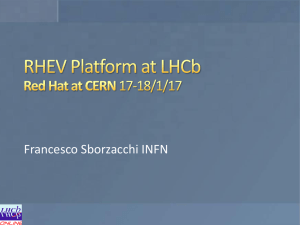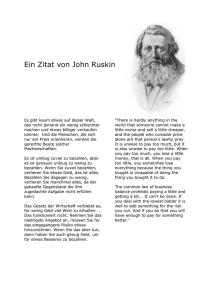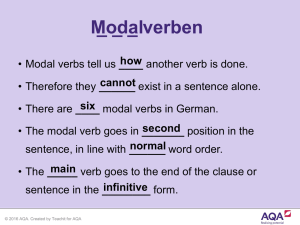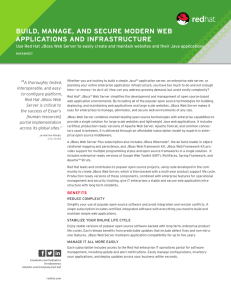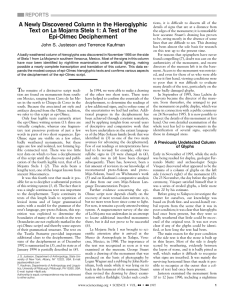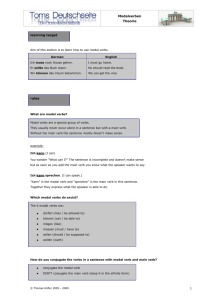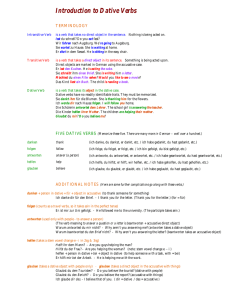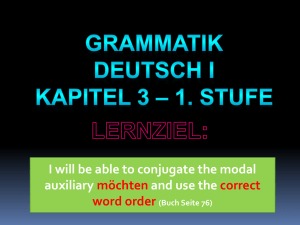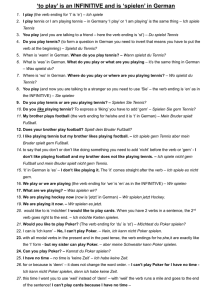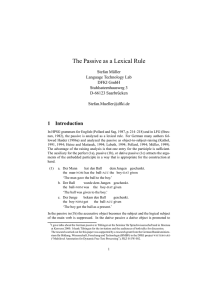A Description of German Syntax Based on a Topological Hierarchy
Werbung
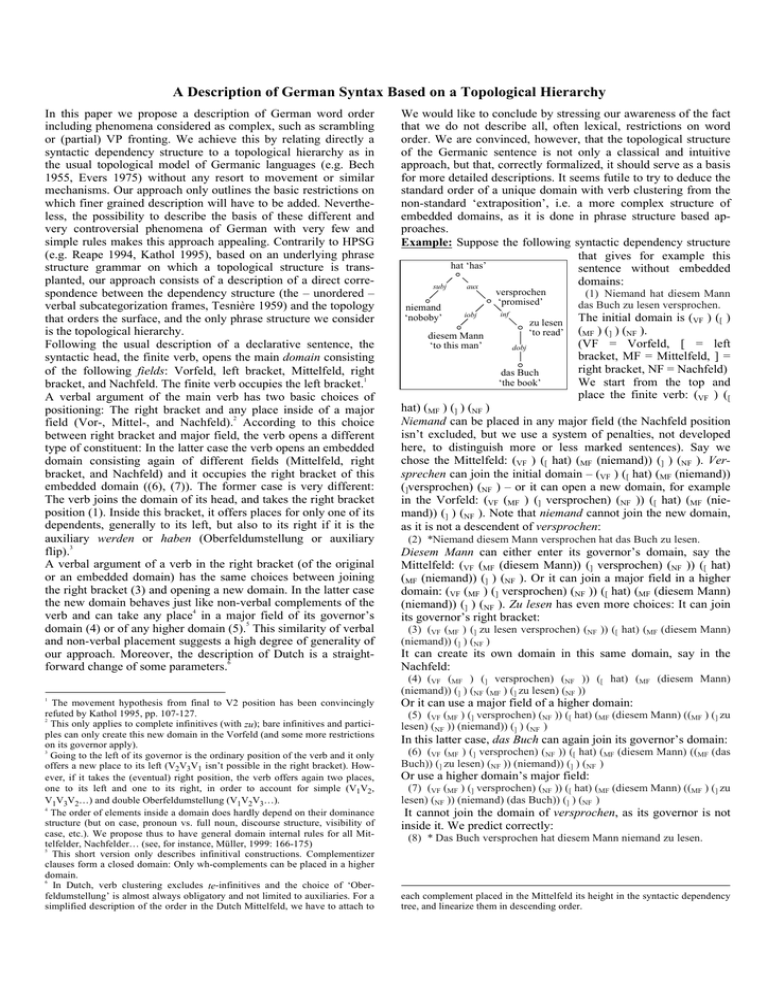
A Description of German Syntax Based on a Topological Hierarchy In this paper we propose a description of German word order including phenomena considered as complex, such as scrambling or (partial) VP fronting. We achieve this by relating directly a syntactic dependency structure to a topological hierarchy as in the usual topological model of Germanic languages (e.g. Bech 1955, Evers 1975) without any resort to movement or similar mechanisms. Our approach only outlines the basic restrictions on which finer grained description will have to be added. Nevertheless, the possibility to describe the basis of these different and very controversial phenomena of German with very few and simple rules makes this approach appealing. Contrarily to HPSG (e.g. Reape 1994, Kathol 1995), based on an underlying phrase structure grammar on which a topological structure is transplanted, our approach consists of a description of a direct correspondence between the dependency structure (the – unordered – verbal subcategorization frames, Tesnière 1959) and the topology that orders the surface, and the only phrase structure we consider is the topological hierarchy. Following the usual description of a declarative sentence, the syntactic head, the finite verb, opens the main domain consisting of the following fields: Vorfeld, left bracket, Mittelfeld, right 1 bracket, and Nachfeld. The finite verb occupies the left bracket. A verbal argument of the main verb has two basic choices of positioning: The right bracket and any place inside of a major field (Vor-, Mittel-, and Nachfeld).2 According to this choice between right bracket and major field, the verb opens a different type of constituent: In the latter case the verb opens an embedded domain consisting again of different fields (Mittelfeld, right bracket, and Nachfeld) and it occupies the right bracket of this embedded domain ((6), (7)). The former case is very different: The verb joins the domain of its head, and takes the right bracket position (1). Inside this bracket, it offers places for only one of its dependents, generally to its left, but also to its right if it is the auxiliary werden or haben (Oberfeldumstellung or auxiliary 3 flip). A verbal argument of a verb in the right bracket (of the original or an embedded domain) has the same choices between joining the right bracket (3) and opening a new domain. In the latter case the new domain behaves just like non-verbal complements of the 4 verb and can take any place in a major field of its governor’s 5 domain (4) or of any higher domain (5). This similarity of verbal and non-verbal placement suggests a high degree of generality of our approach. Moreover, the description of Dutch is a straight6 forward change of some parameters. We would like to conclude by stressing our awareness of the fact that we do not describe all, often lexical, restrictions on word order. We are convinced, however, that the topological structure of the Germanic sentence is not only a classical and intuitive approach, but that, correctly formalized, it should serve as a basis for more detailed descriptions. It seems futile to try to deduce the standard order of a unique domain with verb clustering from the non-standard ‘extraposition’, i.e. a more complex structure of embedded domains, as it is done in phrase structure based approaches. Example: Suppose the following syntactic dependency structure that gives for example this hat ‘has’ sentence without embedded domains: subj aux niemand ‘noboby’ versprochen ‘promised’ iobj diesem Mann ‘to this man’ inf zu lesen ‘to read’ dobj das Buch ‘the book’ (1) Niemand hat diesem Mann das Buch zu lesen versprochen. The initial domain is (VF ) ([ ) (MF ) (] ) (NF ). (VF = Vorfeld, [ = left bracket, MF = Mittelfeld, ] = right bracket, NF = Nachfeld) We start from the top and place the finite verb: (VF ) ([ hat) (MF ) (] ) (NF ) Niemand can be placed in any major field (the Nachfeld position isn’t excluded, but we use a system of penalties, not developed here, to distinguish more or less marked sentences). Say we chose the Mittelfeld: (VF ) ([ hat) (MF (niemand)) (] ) (NF ). Versprechen can join the initial domain – (VF ) ([ hat) (MF (niemand)) (]versprochen) (NF ) – or it can open a new domain, for example in the Vorfeld: (VF (MF ) (] versprochen) (NF )) ([ hat) (MF (niemand)) (] ) (NF ). Note that niemand cannot join the new domain, as it is not a descendent of versprochen: (2) *Niemand diesem Mann versprochen hat das Buch zu lesen. Diesem Mann can either enter its governor’s domain, say the Mittelfeld: (VF (MF (diesem Mann)) (] versprochen) (NF )) ([ hat) (MF (niemand)) (] ) (NF ). Or it can join a major field in a higher domain: (VF (MF ) (] versprochen) (NF )) ([ hat) (MF (diesem Mann) (niemand)) (] ) (NF ). Zu lesen has even more choices: It can join its governor’s right bracket: (3) (VF (MF ) (] zu lesen versprochen) (NF )) ([ hat) (MF (diesem Mann) (niemand)) (] ) (NF ) It can create its own domain in this same domain, say in the Nachfeld: (4) (VF (MF ) (] versprochen) (NF )) ([ hat) (MF (diesem Mann) (niemand)) (] ) (NF (MF ) (] zu lesen) (NF )) 1 The movement hypothesis from final to V2 position has been convincingly refuted by Kathol 1995, pp. 107-127. 2 This only applies to complete infinitives (with zu); bare infinitives and participles can only create this new domain in the Vorfeld (and some more restrictions on its governor apply). 3 Going to the left of its governor is the ordinary position of the verb and it only offers a new place to its left (V2V3V1 isn’t possible in the right bracket). However, if it takes the (eventual) right position, the verb offers again two places, one to its left and one to its right, in order to account for simple (V1V2, V1V3V2…) and double Oberfeldumstellung (V1V2V3…). 4 The order of elements inside a domain does hardly depend on their dominance structure (but on case, pronoun vs. full noun, discourse structure, visibility of case, etc.). We propose thus to have general domain internal rules for all Mittelfelder, Nachfelder… (see, for instance, Müller, 1999: 166-175) 5 This short version only describes infinitival constructions. Complementizer clauses form a closed domain: Only wh-complements can be placed in a higher domain. 6 In Dutch, verb clustering excludes te-infinitives and the choice of ‘Oberfeldumstellung’ is almost always obligatory and not limited to auxiliaries. For a simplified description of the order in the Dutch Mittelfeld, we have to attach to Or it can use a major field of a higher domain: (5) (VF (MF ) (] versprochen) (NF )) ([ hat) (MF (diesem Mann) ((MF ) (] zu lesen) (NF )) (niemand)) (] ) (NF ) In this latter case, das Buch can again join its governor’s domain: (6) (VF (MF ) (] versprochen) (NF )) ([ hat) (MF (diesem Mann) ((MF (das Buch)) (] zu lesen) (NF )) (niemand)) (] ) (NF ) Or use a higher domain’s major field: (7) (VF (MF ) (] versprochen) (NF )) ([ hat) (MF (diesem Mann) ((MF ) (] zu lesen) (NF )) (niemand) (das Buch)) (] ) (NF ) It cannot join the domain of versprochen, as its governor is not inside it. We predict correctly: (8) * Das Buch versprochen hat diesem Mann niemand zu lesen. each complement placed in the Mittelfeld its height in the syntactic dependency tree, and linearize them in descending order. Some References: Bech Gunnar, 1955, Studien über das deutsche Verbum infinitum, 2nd edition 1983, Linguistische Arbeiten, Nr. 139, Niemeyer, Tübingen. Evers Arnoldus, 1975, The transformational cycle in Dutch and German. PhD thesis, University of Utrecht. Grewendorf, Günter, Aspekte der deutschen Syntax (2nd edition), Volume 33 of ‘Studien zur deutschen Grammatik’, Narr, Tübingen, 1991. Haider, Hubert, “The Case of German”, in Jindrich Toman (ed.), Studies in German Grammar, Studies in Generative Grammar, N° 21, Foris Publications, Dordrecht, 1985. Kathol, Andreas, Linearization-Based German Syntax, PhD thesis, Ohio State University, 1995 Mel’cuk, Igor, Dependency Syntax, State University of New York Press, 1988. Meurers, Walt Detmar, “Raising Spirits (and assigning them case)”, in: Werner Abraham (ed.), Groninger Arbeiten zur Germanistischen Linguistik, 4, 1999, 173-226. Müller, Stefan, Deutsche Syntax deklarativ. Head Driven Phrase Structure für das Deutsche, ‘Linguistische Arbeiten’ Nr. 394, Niemeyer, Tübingen, 1999. Reape, M., “ Domain Union and Word Order Variation in German ”, in: J. Nerbonne et al. (eds.), German in Head-Driven Phrase Structure Grammar, CSLI Lecture Notes, N° 46, Stanford, 1994. Rambow, Owen, Formal and Computational Aspects of Natural Language Syntax, Institute For Research in Cognitive Science, PhD thesis, University of Pennsylvania, Philadelphia, 1994. Tesnière Lucien, 1959, Eléments de syntaxe structurale, Paris : Kliencksieck.
